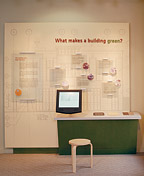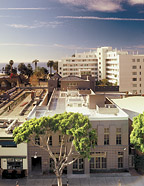

NRDC's new Southern California home will be one of the first buildings in the United States to receive a LEED™ Version 2 Platinum green building rating from the U.S. Green Building Council - the highest possible level of sustainable design. It is a showcase of green construction and maintenance, demonstrating NRDC's philosophy in action.
NRDC's goal in renovating its 15,000-sq-ft Santa Monica space was to design a building that reclaims water and generates electricity from sunlight, is built from recycled or recyclable materials, and makes the most of natural light and sea breeze to minimize the need for artificial lighting and cooling. And, in contrast to opening up new land, the building reuses already urbanized property in a part of the city that encourages walking and use of public transit.
NRDC states that the building, named after actor and activist Robert Redford, uses 60% less water than a standard building of its size by capturing and filtering rain, shower, and sink water to irrigate landscaping and flush toilets. It reduces electricity consumption 60% to 75% by maximizing natural light and using efficient fixtures and appliances, task lighting, dimmable electronic ballasts, occupancy sensors, and extra insulation. The building also meets 20% of its electricity needs through rooftop photovoltaic cells.
The structure used only recycled or recyclable materials, and 98% of the materials left over from dismantling the original building and constructing the new one were reused or recycled. Indeed, all the technologies and materials - from the water-reclamation system and the photovoltaic array, to the pollutant-free adhesives, paints, and materials - are widely available. NRDC notes that these products make cost-efficient sense for builders everywhere.

Supplementing Fresh Air
The Robert Redford Building, which officially opened in November 2003, is a three-story, clapboard structure that reflects its Santa Monica surroundings. Among its more striking features are three multilevel atria with rooftop monitors that diffuse sunlight and fresh air throughout the building.Because of the abundant fresh air available at its oceanside location, it was not even certain that the building needed mechanical cooling. However, it was eventually decided that air conditioning was necessary, and, of course, energy efficiency was the most important criteria. IAQ was also important to the NRDC, and the group wanted to make sure the HVAC system was controlled in conjunction with the natural ventilation scheme.
"Since the building is small and the loads due to envelope and lighting are low, it was decided to use residential-type split systems that were simple to control, easy to maintain, were high in energy efficiency, used non-HCFC refrigerant, and were economical to supplement the natural ventilation," said Rob Bolin, P.E., the LEED accredited vice president for Sustainable Design at Syska Hennessy's Los Angeles office.
The system is comprised of seven Carrier 2- and 3-ton split system air conditioning units whose condensing units are located on the roof. The R-410A units are connected to indoor fancoil units, which are located in closets. The system uses 100% outside air for most of the year, and it is possible to manually adjust the units to recirculate some of the room air during the winter so that the heat in the building is not lost completely.
The air distribution system uses plinth displacement diffusers to deliver cool air at floor level, which then rises to a high level in each room and exits the rooms to the corridor. The corridor air path leads to three roof monitor light wells that also act as the relief air path for air to leave the building. Two whole-building fans located at the top of the roof monitors are provided to flush the building either first thing in the morning or at night after occupants have departed.
Several rooms in the building have no mechanical ventilation or air conditioning. These rooms, which include two conference rooms, a pantry, and a storage/assembly room, rely on natural ventilation by way of operable windows and multispeed ceiling fans to assist in air movement. All of these rooms are west-facing, with operable windows facing breezes from the prevailing west winds.
The system also includes CO2 monitors to signal elevated carbon dioxide levels, indicating to occupants that they should open a window. The filtration system was also upgraded. "We specified custom filter boxes so that MERV-13 filters could be installed," said Bolin. "Most small commercial and residential systems are limited to 1-in. filters in their equipment, and MERV-13 filtration requires either 2-in. or 4-in. sections to fit the filters."
A separate hydronic heating system warms the building, with the exception of the first floor public space, which is served by a heat pump. The heating system uses perimeter convectors that are integral to the plinth displacement diffusers to provide local heating to the office areas. For rooms that do not have plinth diffusers, heating is provided via the convectors. The convectors are interlocked with the operable windows via magnetic switches so that if the window is open, the heating valve is closed.
The hot water is generated by two instantaneous gas-fired Takagi heaters and is moved via a simple circulating pump, all located on the roof. There is a control algorithm that modulates the heating water supply temperature based upon outside air temperature so that only the amount of heating that is required is generated through the heaters.

Unusual Interactive Aspect
An interesting twist to this environmentally friendly project was the fact that NRDC wanted a way in which to show visitors real-time, visual evidence of the building's performance efficiency. The organization asked Southern California Edison (SCE), the electric utility, to develop an energy model for the building, plus a public exhibit located in the Environmental Action Center on the building's first floor, which displays current energy and water savings that is updated hourly.Dubbed the "Green Building Exhibit," the kiosk consists of a monitor built into a larger wall exhibit with pictures of the building and text that explains what makes a building green. On the monitor are four panels depicting solar energy production, water efficiency, heating and cooling energy consumption, and lighting energy consumption. A touch-screen feature allows visitors to call up current energy statistics.
"We thought it would be a great way to educate the public," said Christine Magar, project manager, SCE. "The interactive display uses animation to show water flowing through the pipes, where it's coming from and where it's going to. With the PV system, you see electricity going from the array through electric lines into light fixtures and computers. It's a good way to educate the public about these building systems, which [usually] seem really mysterious."
To obtain the input for this information, SCE needed a network of sensors and an intelligent device to process the data for display. The utility turned to ASW Engineering Management Consultants, Tustin, CA, which helped develop the high-level design for the energy-monitoring system, including the points to be collected, the type of points (i.e., digital or analog), and the panels and instrumentation.
A PC-based server would be the traditional solution, but ASW wanted to provide a more robust solution that wouldn't require any on-site computer maintenance personnel. "To eliminate the costs and inherent maintenance problems of a PC, we chose a LonWorks-based network and the Echelon ‘i.Lon 100' Internet server as an embedded firmware solution," said Dennis Rowan, senior project engineer with ASW.
The exhibit has three parts: the sensors located throughout the building, the i.Lon100 control panel, and the kiosk. Severson Company of Yucaipa, CA, installed 22 sensors and meters throughout the building and those sensor leads terminate in the i.Lon control panel located in the basement electrical room. Sensor outputs are received by the iLon panel through specified LonWorks modules installed by VaCom Technologies of La Verne, CA, an authorized network integrator for Echelon.
The i.Lon panel consists of three i.Lon units and one calculation node. The node was required to provide averaging and other mathematical functions to the sensor inputs, as the i.Lon could not complete these tasks independently. The i.Lons use the input information to generate a series of dynamic webpages for the kiosk.
The building staff is limited and there is no on-site maintenance staff, so the information from the kiosk is not currently fed into any BAS or other type of reporting system. However, information can be retrieved from the kiosk in order to comply with LEED certification, which requires continuous measurement of performance.
"Later this year we will file a report for SCE, which will document the measured energy and water savings. We will create the report based on the data we're collecting from the i.Lons. As it is, we collect and review the data on a monthly basis to make sure everything is working as it should," said Rowan.
NRDC moved into the building last fall, and everyone is pleased with the new Santa Monica office. The special environmental systems, reviews, materials, and building processes added approximately 15% to the cost of the building, but estimates are that those costs will be recouped in three years or less because of resource savings and productivity gains.
As Bolin remarked, "Sustainable buildings can be either very passive or very active. This is a passively conditioned building and requires an active building occupant to participate in maintaining their own thermal comfort. NRDC has proved to be just such an occupant." ES

